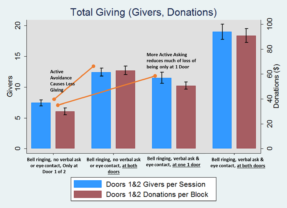To Ask or Not to Ask: The Shakespearean Dilemma of Fundraising
If people enjoy giving, then why avoid a fundraising ask?
Being solicited and the joy that can arrive from being charitable are not synonymous. Heck, sometimes they aren’t even far-flung cousins.
Relatedly, the act of giving is not what brings joy. It’s how the person feels afterwards. I don’t give because I feel sad, I give in hopes of, at bare minimum, not feeling sad and ideally, feeling psychologically rewarded.
Giving is a three-part act:
- Act One: Being solicited
- Act Two: Act of giving or not
- Act Three: How one feels as a result of choice in Act Two
But if Act One never happens because the person avoids being solicited, it’s a short play. Think back to December. Now recall a grocery trip and the inevitable encounter with the Salvation Army bellringers. What did you do? Go in the door where they weren’t? Avoid eye contact? Or maybe seek them out?
Regardless, this isn’t a foreign situation. Everybody knows what’s gonna happen; you’ll be asked to donate whether verbal and explicit or non-verbal and implied.
And by extension everyone has a behavior pattern from their personal past to lean on in these situations. If I gave and felt good about it (vs. pressured or guilted into it) and if I hadn’t given to the bellringer yet this year, I might be inclined to seek them out or at least not actively avoid them.
On the other hand, what if my prior experience felt guilt inducing? Or perhaps it was good, but I gave to the bellringer last week.
An experiment (Andreoni, Rao and Trachtman, 2011) was run outside a grocery store with researchers on site monitoring foot traffic. It was a 2×2 design with 1 door or 2 having Salvation Army bellringers and actively asking versus not.

Giving was lowest with a bell ringer at only 1 of 2 doors and no verbal, active asking and highest at the other end of the continuum – ringers at both doors and both actively asking.
With subsequent analysis the researchers found that avoiders don’t give even when they’re unable to avoid. Said differently, there were plenty of folks who avoided saying no but when unable to avoid it, did so.
The more active asking ‘converts’ those who are not avoiding saying no but rather, avoiding having their empathetic response activated since they know they’ll either give or feel guilty for not doing so. None of this is not sticky giving, it’s fueled by low-quality motivation, a one-off.
The bellringer isn’t getting repeat donations or even donor names, which would be fine except the guilt induced gift doesn’t build brand connection or goodwill, it kills it. It’s short term “gain” for long-term pain.
In another experiment with door to door canvassing the best outcome for the charity and the humans on the other side of the door was to,
- Pre-canvass by hanging door knockers on the residence alerting them to canvassing activity in the coming days
- Letting people leave the tag to opt-out of canvassing
A canvassing shift that hit a much higher percentage of doors where the person was at least willing to have a conversation would be a fantastic shift for the prospects and the canvassers. The goal is not door knocking. The goal is signing people up who will stick around and doing enough of it per shift to turn a profit for the agency and the charity.
All these dynamics play out with passive, non-interpersonal fundraising – i.e. mail, email, digital of all sorts, etc.
How much of our declining acquisition rates and 2nd gift conversion is because we’re trying to convert the unconvertible or trying to keep the new donor who gave for reasons with no staying power?
Donating is not the same as feeling good about it. One of the ways to improve Act One is making it more tailored and personalized to Identity and Personality and making sure it’s need supportive. Another way is being more explicit about how giving will make the donor feel good and doing this in Act One.
Kevin


